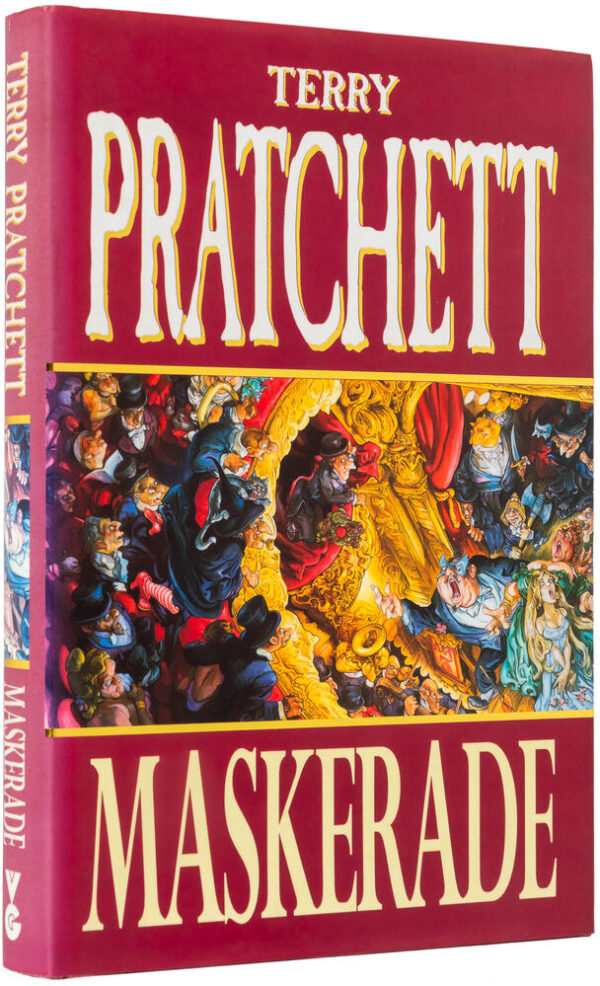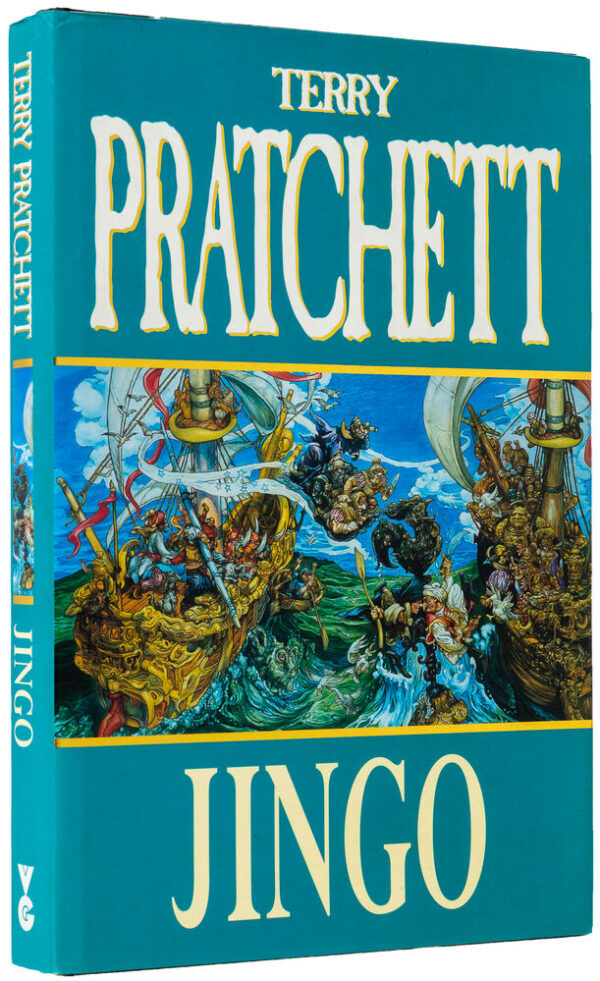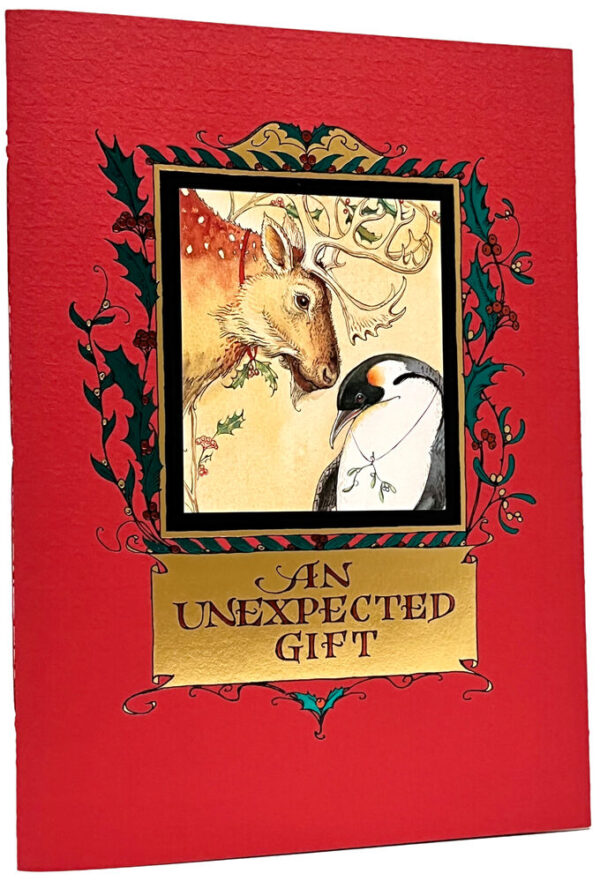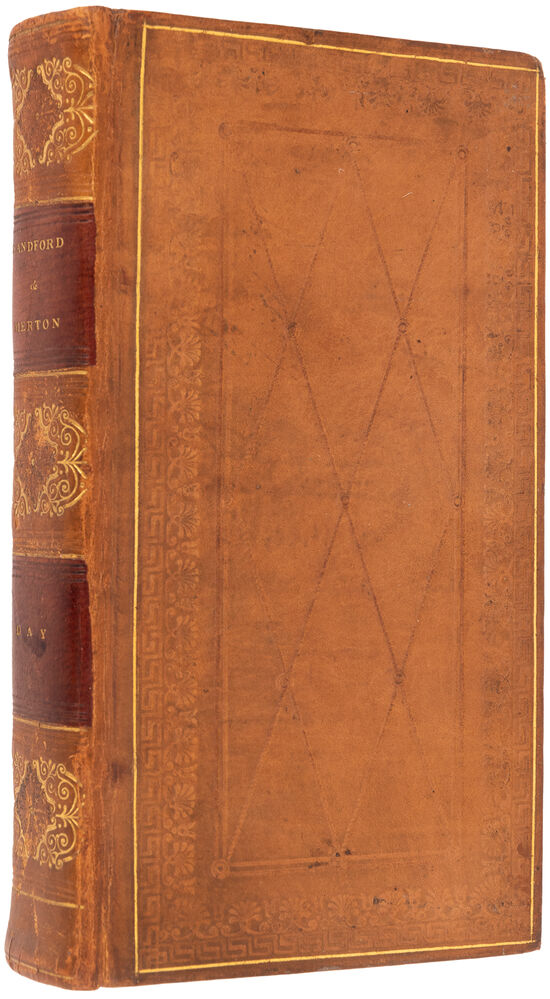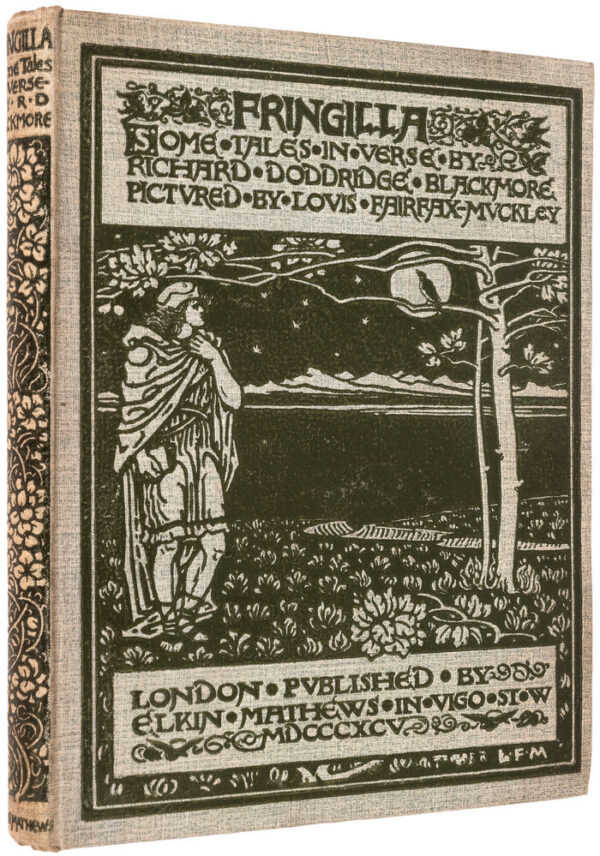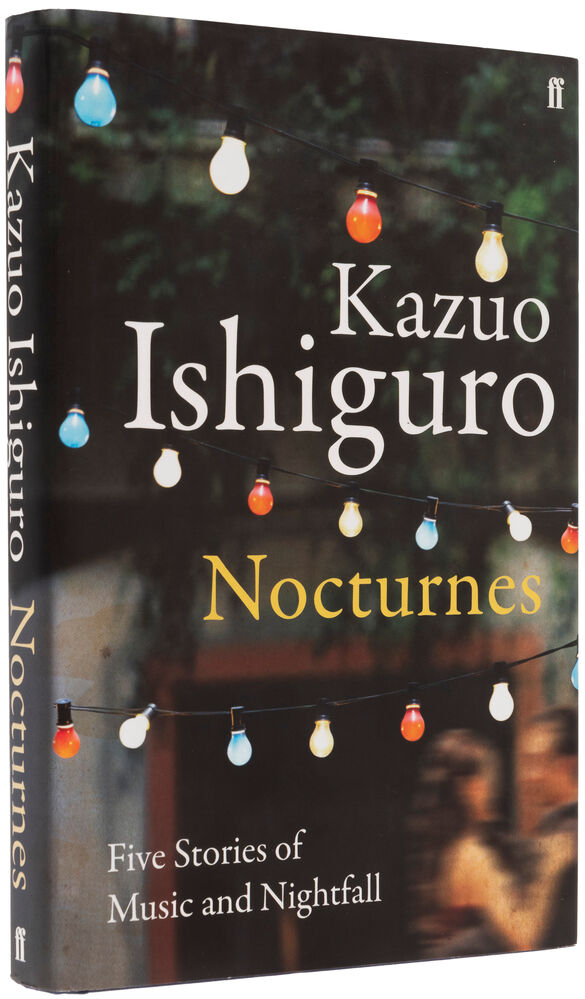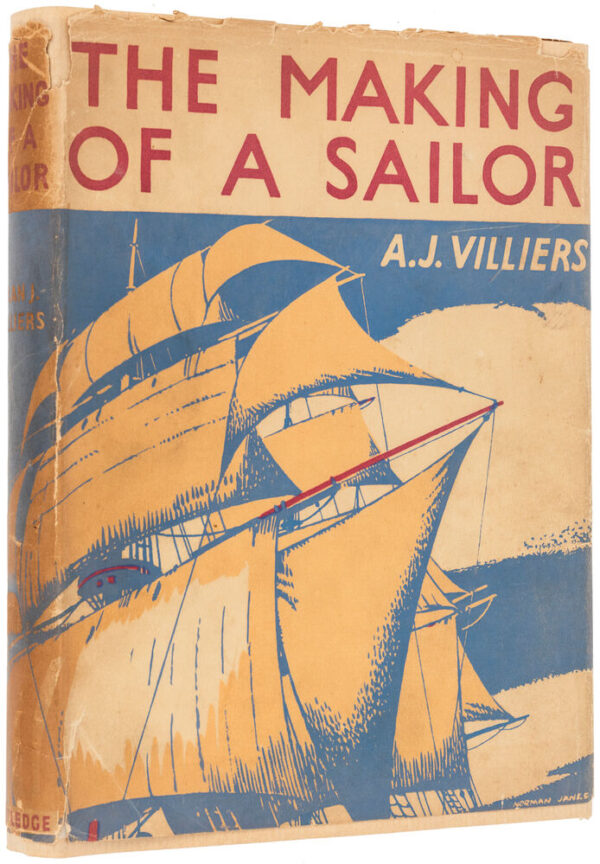
VAN SANDWYK, Charles (author and illustrator).
[North Vancouver]; Charles Van Sandwyk Fine Arts. 2013. 8vo. Original cherry-red card jacket exquisitely embellished in green and red foil with border and lettering panel in burnished gilt over gilt card with an onlaid pictorial card plate to upper cover depicting a reindeer and a penguin; pp. [44], including beautiful matt gilt endpapers with a repeating design of holly sprigs in colours; with text pages printed in green on cream laid paper, with decorations in red; with 7 fine full colour plates (including 1 double-page spread), some printed on untrimmed handmade paper, together with other plates and vignettes in sepia and red; a fine copy. First edition, signed in ink by the artist below the illustration of the penguin and the polar bear with the mistletoe. One of Charles van Sandwyk's sought-after Christmas books. A gentle, and traditional, tale of Bartholomew the Green, cousin of Father Christmas, who leaves Antarctica on a mission to restore an old-fashioned Christmas to a wayward and needy world.

DAY, Thomas.
London: Walker and Evans et al., 1815. 12mo. Full calf, spine lettered in gilt on morocco labels; boards filleted in gilt and ornamented in blind; gilt dentelles; marbled edges; pp. xii, 420; with two engraved frontispieces; minimal bumping to corners and rubbing to extremities; contemporary ownership inscription in ink to front fly-leaf; slight spotting to text, a very good copy. First published in 1783, this was a popular educational work for children. Following the lives of two young boys, Tommy Merton and Harry Sandford. As the pair work through different challenges and experiences, Day communicates simple yet important moral lessons and virtues in topics such as friendship, honesty, and hard work.

BLACKMORE, Richard Doddridge
London: Wlkin Mathews, 1895. 4to., sage green cloth elaborately blocked and lettered in dark green to both boards and spine, with a central circular motif featuring a bird to the lower cover; pp. [ix], 2-128, 20 [ads.]; with full decorative title; proliferated throughout with borders, initials and full-page illustrations by Louis Fairfax Muckley, and three by James W. R. Linton; all behind mounted tissue-guards; edges, endpapers and tissue guards a little browned; evidence of a former bookplate being removed from the front paste-down; some light spotting to prelims; still a lovely example, a little pushed to corners and head/foot of spine. First edition, published simultaeously with the American edition, also printed in 1895, which had parallel illustrations by Will Bradley. "Can'st thou suppose it right or just, When thine own creature so misled us, In virtue of our simple trust, To torture us like this, and tread us Back into dust? Often referred to as the "Last Victorian", R. D. Blackmore is best known for his magnum opus Lorna Doone, and much of his other work has faded into obscurity. Despite this fact, however, he achieved literary merit and acclaim in his time for his vivid descriptions and personification of the countryside, sharing with Thomas Hardy a Western England background and a strong sense of regional setting in his works. One reviewer writes, of his work: "He may be said to have done for Devon what Sir Walter Scott did for the Highlands and Hardy for Wessex." Fringilla, as a series of tales told in verse, focuses on Blackmore's love of nature, but also includes poems which explore themes of Egypt, Good and Evil, Religion, Myths and Legends.

SABUDA, Robert.
London; Simon & Schuster UK Ltd. 2005. Small 4to.; publisher's teal cloth-backed pictorial boards illustrated in colour and heightened in white glitter; opening to reveal 6 dramatic and intricate double-page pop-up scenes printed in icy colours, silvers, whites, greens, blues and lilacs, with additional folding flaps revealing more pop-up surprises, and a musical chip on the lower cover with the cellophane still attached, so presumably unused and operational; a very good copy with light external dusting; internally very clean and crisp throughout. First UK edition, first printing, of this three-dimensional winter extravaganza.

London, Doubleday, 1999. 8vo. Original red cloth, title gilt to spine, with illustrated dust wrapper; pp.317; very good, with authorial signature to title. First edition, signed by the author. The 24th book in the discworld series, and the 5th City Watch novel. This novel features a trip to Uberwald, the theft of a scone, and introduces the clacks, a long-distance semaphore system.

London: Faber and Faber, 2015. 8vo., original grey boards lettered in gilt to spine; blue endpapers; housed in the original unclipped dust jacket (£20.00); with a photograph of the author to the lower flap; pp. [viii], 3-345, [i]; a near-fine copy, lightly compressed to spine tips and with one small coffee splash to the upper edge; small scratch to outer edge of text block; near-fine jacket lightly rubbed at edges. First edition, with full number line 1-10, boldly signed by the author to the title page. A fantasy novel by the Nobel Prize-winning British writer Kazuo Ishiguro, following the lives of an elderly couple, Axl and Beatrice, who live in a fictional post-Arthurian England in which no-one is able to retain long-term memories.

London: Faber and Faber, 2003. Large thick 8vo., navy cloth-backed orange boards, painted red label gilt to spine; maroon endpapers; matching maroon slipcase; pp. [vi], v-xli, [iii], 3-1333, [i]; a fine copy, just a couple of small marks to the slipcase. Limited edition, one of just 200 copies specially bound, this no. 176. With original tipped-in label from the publisher loosely inserted. A collection of several hundred poems, which range from Hughes' early life, through to some of his more famous works (Crow, Wodwo, Cave Birds, Birthday Letters, Gaudete), along with many uncollected.

London; Dent, Pennant Books. 1968. 8vo.; publisher's forest-green and acid-yellow cloth, in pictorial dustwrapper; pp. [viii], ix-[x] + 231 + [i]; with line illustrations throughout by Ruth Gervis; a near fine copy, both inside and out, with a tiny dint to bottom edge of upper cover, in a near fine, price-clipped dustwrapper retaining the original bookseller's price sticker to upper flap (£1.10) and with slight fading to spine. Vintage edition with the original illustrations by Gervis, inscribed in ink by Noel Streatfeild to front blank, "For Davida Hodson, Noel Streatfeild". Signed copies of this title are rare in commerce. This is the first such copy handled by us in over thirty-five years and the only signed copy of the title located on the commercial market at the time of cataloguing.

London, Secker & Warburg and The Book Society, 1953. 8vo. Original boards with illustrated dust-wrappers (not price-clipped), map endpapers; pp. 320; light marginal war to wrappers, otherwise very good. First English edition. 'In her magnificent novel, Marguerite Yourcenor recreates the life and death of one of the great rulers of the ancient world. The Emperor Hadrian, aware his demise is imminent, writes a long valedictory letter to Marcus Aurelius, his future successor. The Emperor meditates on his past, describing his accession, military triumphs, love of poetry and music, and the philosophy that informed his powerful and far-flung rule. A work of superbly detailed research and sustained empathy, Memoirs of Hadrian captures the living spirit of the Emperor and of Ancient Rome' (Penguin Classics blurb).

North Vancouver, B.C.; The Fairy Press. A division of Charles van Sandwyk Fine Arts. [2023]. 8vo.; original plum-coloured card covers, hand-sewn to spine, with large onlaid pictorial plate to upper panel surrounded by an attractive winding twig-and-leaf border in metallic bronze; pp. [8], printed on fine ivory-coloured card; with finely printed calligraphic text throughout, illustrated title-page in colours, one fine double-page plate in colours, 3 other coloured vignettes, and one page affixed with a mounted marbled-paper pocket, surrounded by decorative floral scrolls, containing a folded 3-leaf mini fairyland panorama in colours, and 2 adjacent gatefold leaves opening to reveal a 4-page fairyland gathering; fine. First edition, signed in ink by Charles van Sandwyk to the final page. In 2012 the illustrator produced a miniature work entitled "Will O' The Wisps" in an edition of only 35 numbered copies. It consisted of a panorama printed in sepia presented in a wallet. Here van Sandwyk reworks the concept by including the tiny folding panorama in a pocket and showcasing it in a larger format, in book form, with an accompanying double-page coloured plate and other coloured fairyland vignettes.
